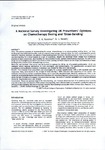A National Survey Investigating UK Prescribers' Opinions on Chemotherapy Dosing and ‘Dose-Banding’
| dc.contributor.author | Kaestner, SA | |
| dc.contributor.author | Sewell, GJ | |
| dc.date.accessioned | 2015-10-27T16:20:53Z | |
| dc.date.available | 2015-10-27T16:20:53Z | |
| dc.date.issued | 2009-05 | |
| dc.identifier.issn | 0936-6555 | |
| dc.identifier.issn | 1433-2981 | |
| dc.identifier.uri | http://hdl.handle.net/10026.1/3711 | |
| dc.description.abstract |
AIMS: The primary purpose of dose-banding for cancer chemotherapy is to reduce patient waiting times, but dose-banding also has additional benefits, such as reduced drug wastage, reduced stress for staff, and prospective quality control of infusions. However, the uptake of dose-banding seems fairly low. Possible reasons for this are a reluctance to use dose-banding for clinical reasons or a lack of awareness. Despite the seemingly minor change from established practice of dose preparation, dose-banding has the potential to alter patient chemotherapy exposure. The aim of this study was to investigate prescribers' awareness of dose-banding and their opinions on the scope and limitations of dose-banding in the context of UK chemotherapy services. MATERIALS AND METHODS: This survey was performed throughout the UK by use of a postal questionnaire, which was validated before national distribution to 1104 oncologists and haematologists. The questionnaire contained both quantitative and qualitative elements. A database was created for data entry and analysis. RESULTS: The response from prescribers was encouraging for a postal questionnaire, with a 35% response rate (387 responses). Many were aware of the concept of dose-banding (>80%) and were also supportive of the system. The weakness around body surface area-based dosing was a commonly discussed topic. However, opinions on which is the maximum acceptable deviation from the prescribed dose with dose-banding were controversial, and there was a concern about the lack of evidence to support the use of dose-banding. The views on whether carboplatin and targeted therapies should be dose-banded were also divided. CONCLUSIONS: There was general support for dose-banding, but concerns about the lack of an evidence base could be a barrier to the wider introduction of the system. Consequently, more clinical studies are required to justify the safety and efficacy of dose-banding, and also to evaluate whether dose-banding is acceptable within clinical trials. | |
| dc.format.extent | 320-328 | |
| dc.format.medium | Print-Electronic | |
| dc.language | en | |
| dc.language.iso | eng | |
| dc.publisher | Elsevier BV | |
| dc.subject | Chemotherapy | |
| dc.subject | dose | |
| dc.subject | dose-banding | |
| dc.subject | prescribers | |
| dc.subject | survey | |
| dc.subject | UK | |
| dc.title | A National Survey Investigating UK Prescribers' Opinions on Chemotherapy Dosing and ‘Dose-Banding’ | |
| dc.type | journal-article | |
| dc.type | Journal Article | |
| plymouth.author-url | https://www.webofscience.com/api/gateway?GWVersion=2&SrcApp=PARTNER_APP&SrcAuth=LinksAMR&KeyUT=WOS:000265316100008&DestLinkType=FullRecord&DestApp=ALL_WOS&UsrCustomerID=11bb513d99f797142bcfeffcc58ea008 | |
| plymouth.issue | 4 | |
| plymouth.volume | 21 | |
| plymouth.publication-status | Published | |
| plymouth.journal | Clinical Oncology | |
| dc.identifier.doi | 10.1016/j.clon.2008.12.004 | |
| plymouth.organisational-group | /Plymouth | |
| plymouth.organisational-group | /Plymouth/Faculty of Health | |
| plymouth.organisational-group | /Plymouth/REF 2021 Researchers by UoA | |
| plymouth.organisational-group | /Plymouth/REF 2021 Researchers by UoA/UoA03 Allied Health Professions, Dentistry, Nursing and Pharmacy | |
| plymouth.organisational-group | /Plymouth/REF 2021 Researchers by UoA/UoA03 Allied Health Professions, Dentistry, Nursing and Pharmacy/UoA03 Allied Health Professions, Dentistry, Nursing and Pharmacy MANUAL | |
| plymouth.organisational-group | /Plymouth/Research Groups | |
| plymouth.organisational-group | /Plymouth/Research Groups/Institute of Health and Community | |
| plymouth.organisational-group | /Plymouth/Users by role | |
| dc.publisher.place | England | |
| dcterms.dateAccepted | 2008-12-03 | |
| dc.identifier.eissn | 1433-2981 | |
| dc.rights.embargoperiod | Not known | |
| rioxxterms.versionofrecord | 10.1016/j.clon.2008.12.004 | |
| rioxxterms.licenseref.uri | http://www.rioxx.net/licenses/all-rights-reserved | |
| rioxxterms.licenseref.startdate | 2009-05 | |
| rioxxterms.type | Journal Article/Review |


